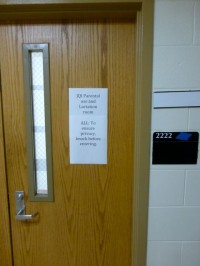By Margaret Harris at the APS March Meeting in Baltimore
“Science remains institutionally sexist. Despite some progress, women scientists are still paid less, promoted less, win fewer grants and are more likely to leave research than similarly qualified men.” The opening lines of Nature’s recent special issue make an arresting – if depressing – summary, so it’s not surprising that Roxanne Hughes chose them to kick off yesterday’s press conference on women in science, technology, engineering and mathematics (STEM) at the APS March Meeting.
Hughes, an education expert at the US National High Magnetic Field Laboratory, spoke about a study she’d done of 26 women undergraduates. All of them entered university with the intention of studying a STEM subject, and 12 had enrolled in a “living and learning community” that offered specialized mentoring opportunities and the chance to live with other female science students. Such programmes have often been touted as a way of helping women persist in science, but on Hughes’ evidence, this particular one made not a whit of difference, at least in numerical terms. The 12 students in the study who switched to non-STEM fields were evenly split between those who participated and those who didn’t.
The next speaker, Luis Amaral of the Howard Hughes Medical Institute, had examined gender differences in publication rates and impact for 4000 scientists (1000 of them women) in seven STEM disciplines. He and his colleagues found that while women do publish, on average, fewer papers than men, the difference shrinks significantly when you take seniority into account, and the difference that remains is much larger in resource-intensive fields such as biomedicine. This, Amaral argued, is evidence that the publication gap is down to the fact that women scientists have access to fewer resources, on average, than their male counterparts. To support this conclusion, he and his colleagues examined the impact factors of papers published by women and men with similar publication records. Now the shoe was on the other foot: the impact factors of women-authored papers were, on average, significantly higher. Amaral attributed this to a “survival of the fittest” effect: in order to persist in the field, women in STEM need to be much better than the average.
So in summary, women scientists get fewer resources, they have to be much better than average to succeed, and some well-intentioned efforts to help them aren’t working.
And yet. And yet. There are some signs of progress, and I saw one of them during a side trip to Maryland’s Joint Quantum Institute earlier this week. Deep in the basement of the JQI, in among the labs dedicated to atom and ion trapping, is the room pictured to the right. “JQI parental use and lactation room” reads the sign on the door. “To ensure privacy, knock before entering.”
I’ve shown this sign to a number of women at the APS March Meeting. Every one of them has marvelled at it, but the reaction of Mildred Dresselhaus was particularly sweet. Now in her early 80s, the redoubtable nanotechnology pioneer has seen a lot of amazing things in her career, and as she gazed intently at my camera, she broke into a broad grin. “Wonderful,” she said, shaking her head as she handed the camera back to me. “Just wonderful.”

Guidelines
Show/hide formatting guidelines
this text was deletedwhere people live in harmony with nature and animals</q>
Some text